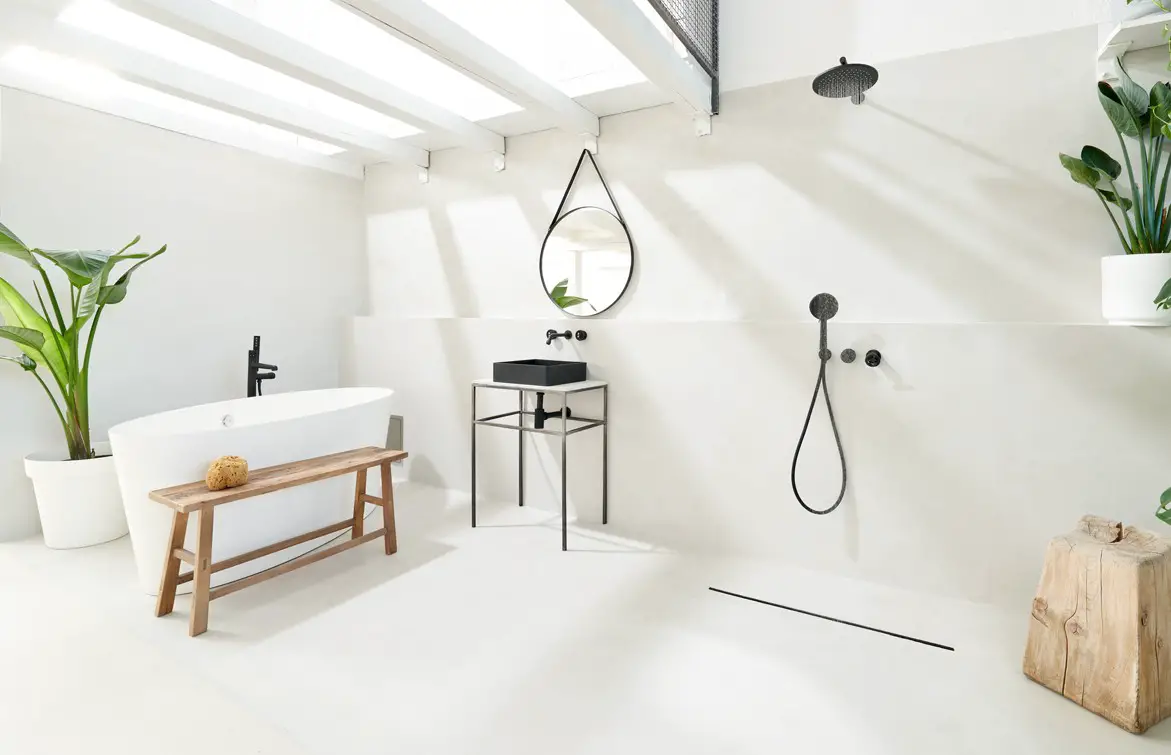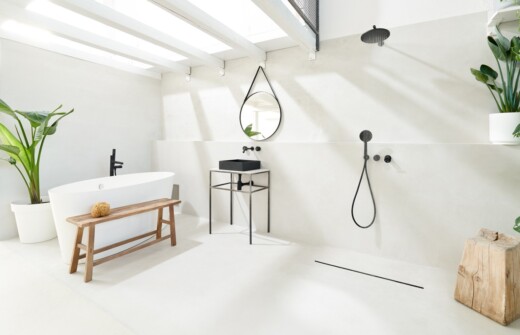How to obtain the effect of a concrete wall guide, High-quality finishing material, Microcement interior design styles
How to obtain the effect of a concrete wall?
18 August 2023
The concrete wall effect is gaining popularity in modern interior design, attracting the attention of both designers and decor enthusiasts with its rawness, minimalist charm and unique texture. Concrete, although often associated with cold, industrial spaces, successfully finds its place in warm, domestic interiors as well. This unique, unmistakable look of concrete can be achieved with microcement, an innovative material that combines elegance and strength.
What is microcement?
Microcement is a high-quality finishing material that is gaining popularity due to its unique combination of durability, flexibility and aesthetics. Its composition is based mainly on a mixture of cement and special polymers, which give it an extraordinary ability to adhere to various surfaces, creating uniform, seamless finishes.
The material was developed in response to growing market demand for materials that allow the creation of finishes that have the appearance of concrete, but are also easier to use and have broader applications.
Properties of microcement
The popularity of microcement comes from its unique properties, which make it an excellent choice for those who want to give their spaces a raw yet modern concrete look. Here are some of the most important features of microcement that contribute to its attractiveness:
- Versatility of application: Thanks to its unique ability to adhere to almost any surface, microcement can be used on floors, walls, stairs, kitchen countertops, furniture, ceilings and even in wet areas such as bathrooms and showers.
- Durability and damage resistance: Microcement is an extremely durable material that resists scratches, cracks and wear, making it ideal for applications that require durability, such as floors and kitchen countertops.
- Water Resistance: As a water-resistant material, microcement is an excellent choice for rooms that are exposed to moisture, such as bathrooms and kitchens.
- Aesthetics: Microcement is available in a wide range of colors and textures, allowing you to create almost any finish effect.
- Hypoallergenic: Microcement contains no volatile organic compounds (VOCs), which means it is safe for allergy sufferers.
- Easy to clean: The lack of joints on the surface of microcement makes it very easy to clean and maintain.
Microcement applications
Valued for its versatility, microcement is used in all kinds of spaces, both private and public.
Due to its durability and scratch resistance, it is an ideal material for use in high-traffic areas – for example, in corridors or conference rooms. The same goes for living rooms, where microcement creates a unique, modern atmosphere.
The use of microcement on staircases allows it to fit precisely into a variety of shapes and angles. It is its flexibility that makes it ideal for places with irregular forms.
It is also a solution that combines elegance and functionality, especially in wet areas. It is perfect for finishing showers, bathroom walls and floors, as well as the space between kitchen cabinets and the countertop.
Kitchen and bathroom countertops, and even furniture, can also be finished with microcement, as the material combines durability, ease of cleaning and aesthetics. The wide range of colors and finishes available makes it possible to create an interior tailored to individual preferences.
Thanks to its weather resistance, microcement can also be used on terraces and balconies, giving them not only style, but also durability. No matter where it is used, microcement always brings a touch of modernity and unique character to the interior.
Microcement and interior design styles
Another of microcement’s advantages is its universal appeal, which allows it to be used in many different interior styles.
Industrial style
In the industrial style, where austerity and simplicity of forms dominate, microcement is ideally suited as a material resembling untreated concrete. Used on floors, walls or kitchen countertops, it adds an authentic, raw character to interiors.
Minimalist style
Minimalist style, on the other hand, focusing on simplicity and functionality, requires materials that are not only aesthetically pleasing, but also easy to maintain. Microcement, with its ease of cleaning and stain resistance, will work well here.
Scandinavian style
In Scandinavian style, based on bright, warm colors and natural materials, microcement can become an element that combines all these features. With a wide range of colors and textures to choose from, it can refer to natural shades of wood or stone.
Loft style
Loft style, with its rawness and untreated surfaces, practically asks for the use of microcement. On walls, floors and even ceilings, microcement can help create original, unique spaces.
Rustic style
Finally, in a rustic style that draws on tradition and natural materials, microcement can provide a modern complement to wooden furniture or stone flooring.
Comments on this guide to How to obtain the effect of a concrete wall article are welcome.
Architecture
Rowanbank Gardens Edinburgh Housing
West Town Edinburgh Property Vision
Comments / photos for the How to obtain the effect of a concrete wall advice page welcome





